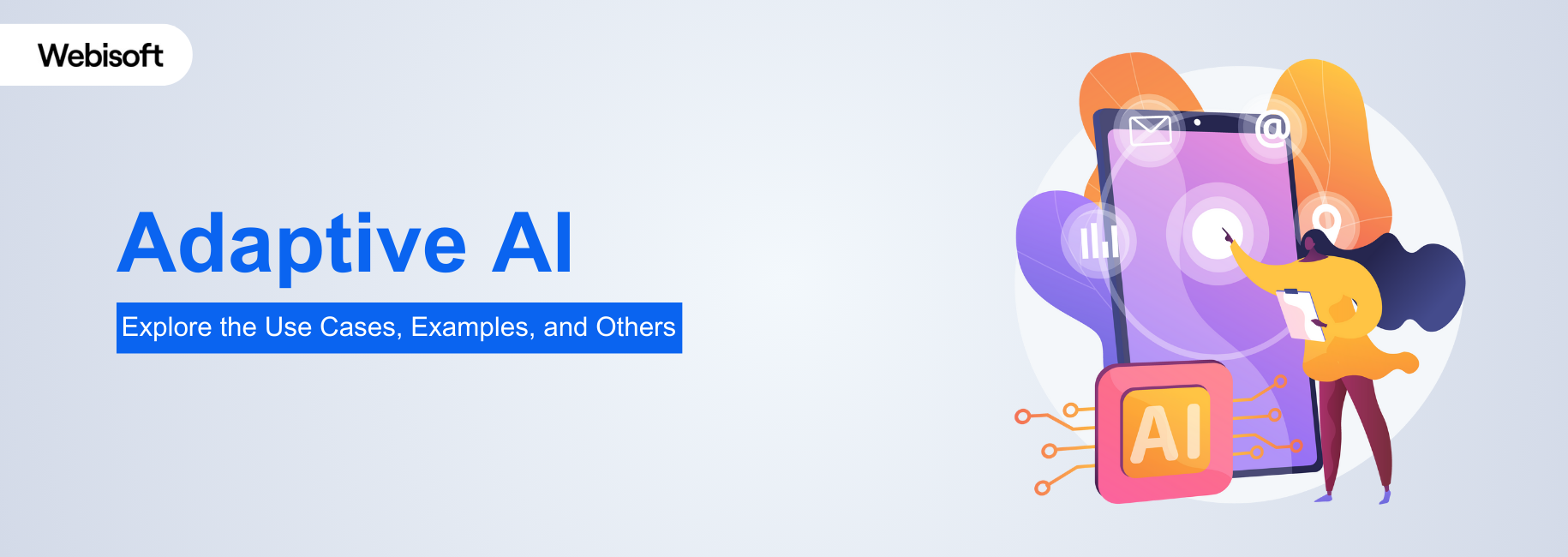Did you know the AI market will reach $190.61 billion by 2025? Adaptive AI is a big reason for this growth. So, are you curious about what exactly is adaptive AI?
Adaptive AI is smart tech that changes its actions based on new data. It learns from what happens around it, getting better without needing our constant guidance. Moreover, adaptive AI can make your experience more personalized, make better choices, work faster, and even cut costs.
So, choosing adaptive AI puts you ahead as it’s perfect for predicting customer needs, smoothing out your operations, and quickly solving new problems. It also spots trends and insights that might take us too long to see.
In today’s guide, we will reveal all the details of adaptive AI, including its benefits, key components, best practices, and others. So, keep going!
Contents
- 1 What is Adaptive AI?
- 2 What are the Benefits of Adaptive AI?
- 3 Key Components of Adaptive AI
- 4 How Adaptive AI Works?
- 5 How to Implement Adaptive AI?
- 6 12 Best Practices for Adaptive AI Implementation
- 6.1 Re-engineer Processes
- 6.2 Increase Decision Intelligence Capabilities
- 6.3 Create a Superior User Experience
- 6.4 Understanding the Problem and Defining Goals
- 6.5 Acquiring High-Quality Training Data
- 6.6 Selecting the Right Algorithms
- 6.7 Regular Performance Monitoring
- 6.8 Handling Concept Drift
- 6.9 Implementing a Tough Testing and Validation Framework
- 6.10 Monitoring Fairness and Ethics
- 6.11 Explainable AI for Transparency and Trust
- 6.12 Ensuring Robustness and Security
- 7 Exploring the Differences: Traditional AI vs Adaptive AI
- 8 Adaptive Intelligence vs Artificial Intelligence
- 9 12 Adaptive AI Use Cases
- 9.1 Industrial Monitoring
- 9.2 Fraud and Anomaly Detection
- 9.3 Agricultural Surveillance
- 9.4 Investments, Trading, and Other Commercial Financial Activities
- 9.5 Autonomous Vehicles
- 9.6 Training and Education
- 9.7 Personalized Recommendations and Services
- 9.8 Robotics
- 9.9 Better Customer Service Chatbots
- 9.10 Supply Chain Improvements
- 9.11 Healthcare Diagnostics
- 9.12 Knowledge Management
- 10 Ethical Considerations & Challenges: Exploring the Complexities of Adaptive AI
- 11 The Future of Adaptive AI: What to Expect?
- 11.1 Industry Cloud Platforms: Driving Business Growth
- 11.2 Enhancing Developer Experience with Platform Engineering
- 11.3 Sustainable Technologies
- 11.4 Embracing Sustainable Technology Trends
- 11.5 Digital Immune System
- 11.6 The Power of Observability
- 11.7 Super-Apps
- 11.8 Considering the Strategic Technology Trends
- 12 How Webisoft Help to Implement Adaptive AI for Your Business?
- 13 Final Note
- 14 Frequently Asked Questions
What is Adaptive AI?
Adaptive AI is smart tech that changes its actions on its own to fit new situations. It learns from experience, unlike regular AI, which sticks to a script. This makes it really useful for businesses that deal with changing conditions.
However, adaptive artificial intelligence gets better over time, solving problems in many areas like fraud detection and customer communication. It uses smart algorithms to quickly analyze data and make decisions, helping businesses act fast and competent.
What are the Benefits of Adaptive AI?
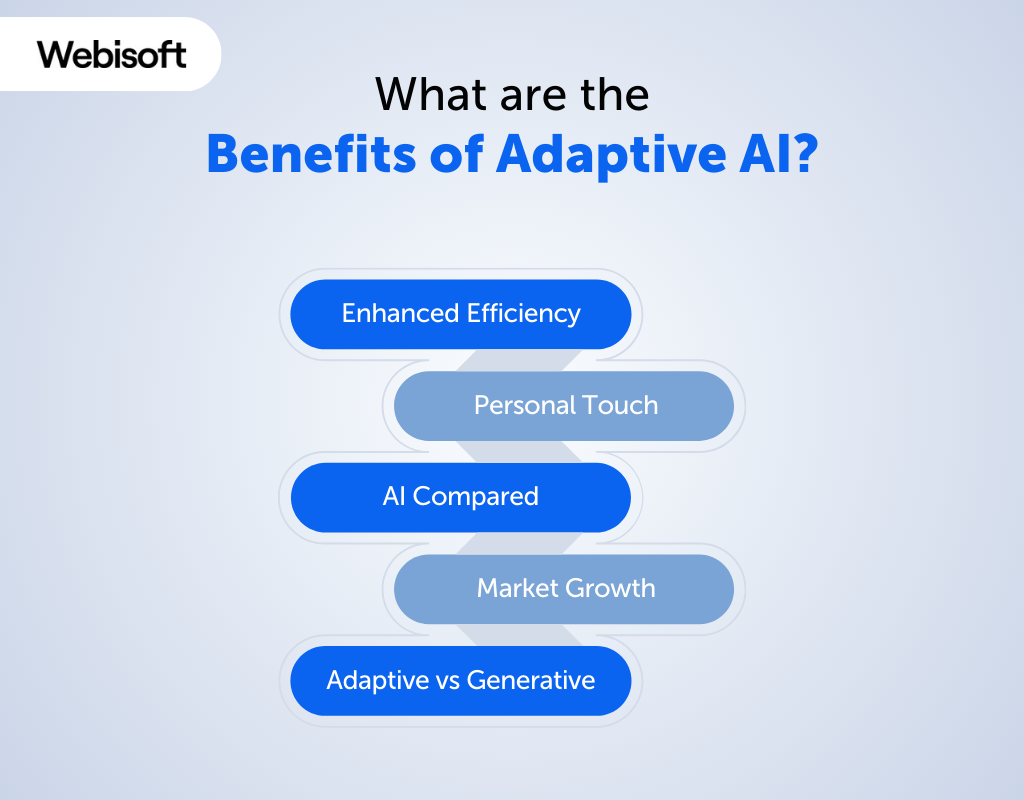
Adaptive AI brings a lot of benefits, from making your work more efficient to adding a personal touch to services. Its ability to learn and adapt is setting new standards in technology, reshaping how industries operate.
However, the advantages of adaptive AI are:
Enhanced Efficiency
Adaptive AI makes things run smoother and faster. It picks up on patterns and predicts outcomes, cutting down mistakes and speeding up decision-making. You’ll see tasks getting done quicker and with fewer errors, all without needing someone to constantly check the work.
Personal Touch
Adaptive AI tools know your preference. They look at your habits and choices and then suggest things that fit you best. Whether for shopping or content, you get recommendations that feel personalized just for you. This not only makes you happier but also keeps you coming back.
AI Compared
When we put adaptive AI next to traditional AI, the difference is clear. Traditional AI follows set rules, but adaptive artificial intelligence learns from new data as it comes. Thus, it can keep up with changes, giving you solutions that are always up to date.
Market Growth
The demand for adaptive AI is on the rise, showing that businesses want to stay ahead with the latest tech. This growing interest is a sign that more dynamic and responsive technologies are becoming the norm.
Adaptive vs Generative
Looking at adaptive AI vs generative AI, it’s all about how they adapt. Adaptive AI focuses on changing its answers based on new info, while generative AI is about creating new stuff. Adaptive AI’s strength is in its ability to keep learning and adjusting, making it super useful for ongoing tasks.
Key Components of Adaptive AI
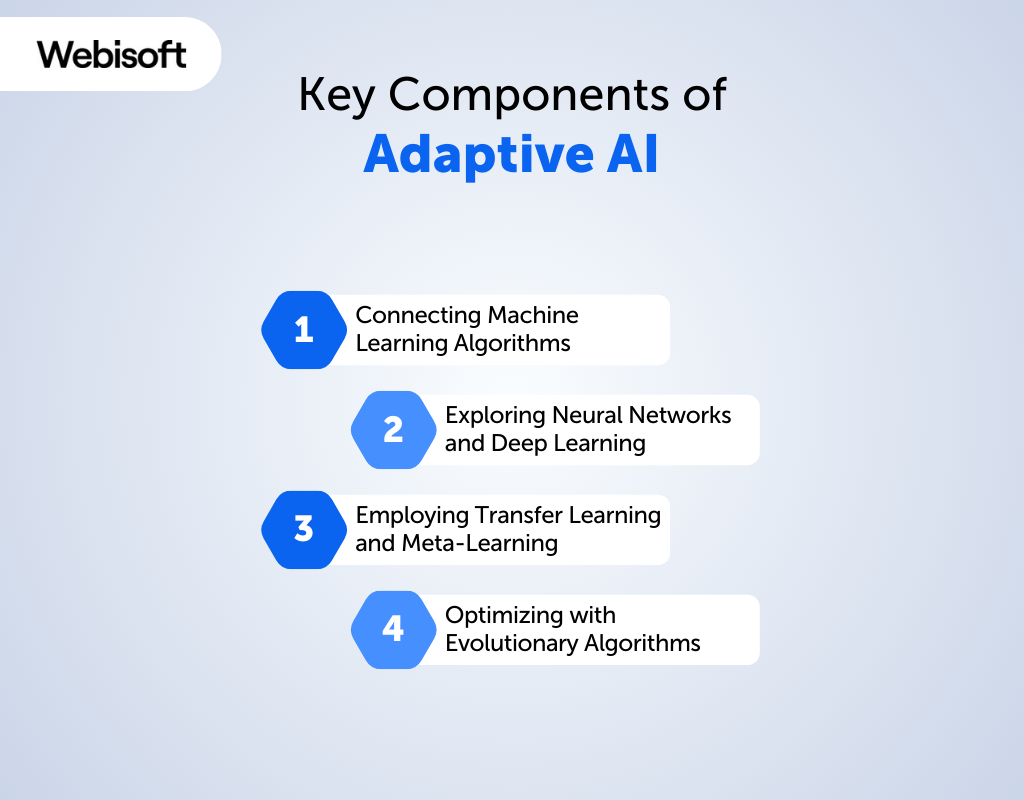
Adaptive AI is a smart technology that gets better over time by learning and adjusting. Let’s break down its key components:
Connecting Machine Learning Algorithms
Machine learning is where AI gets its ability to learn from data and then use what it knows to make predictions or decisions. It comes in three main types:
- Supervised Learning: AI gets data that’s already organized (labeled) and learns to match new data to known outcomes.
- Unsupervised Learning: Here, AI looks at data that’s not organized and tries to find patterns or groups by itself.
- Reinforcement Learning: AI learns through trial and error, changing its approach based on the rewards or penalties it receives.
Exploring Neural Networks and Deep Learning
Neural networks are designed like the human brain, with layers of nodes or neurons that work together.
Deep learning uses extensive neural networks with many layers to find complex patterns in data. This helps AI do things like recognize images, understand spoken words, and process natural language.
Employing Transfer Learning and Meta-Learning
Transfer learning lets AI use knowledge from one task on a different but related task. This makes learning faster because it doesn’t have to start from scratch.
Meta-learning, or “learning to learn,” trains AI to improve how it learns. Thus, it can pick up new tasks or adjust to changes better and faster.
Optimizing with Evolutionary Algorithms
Evolutionary algorithms draw inspiration from nature’s way of evolving. Adaptive AI uses these to get better over time, selecting the best options and making small changes to improve.
How Adaptive AI Works?
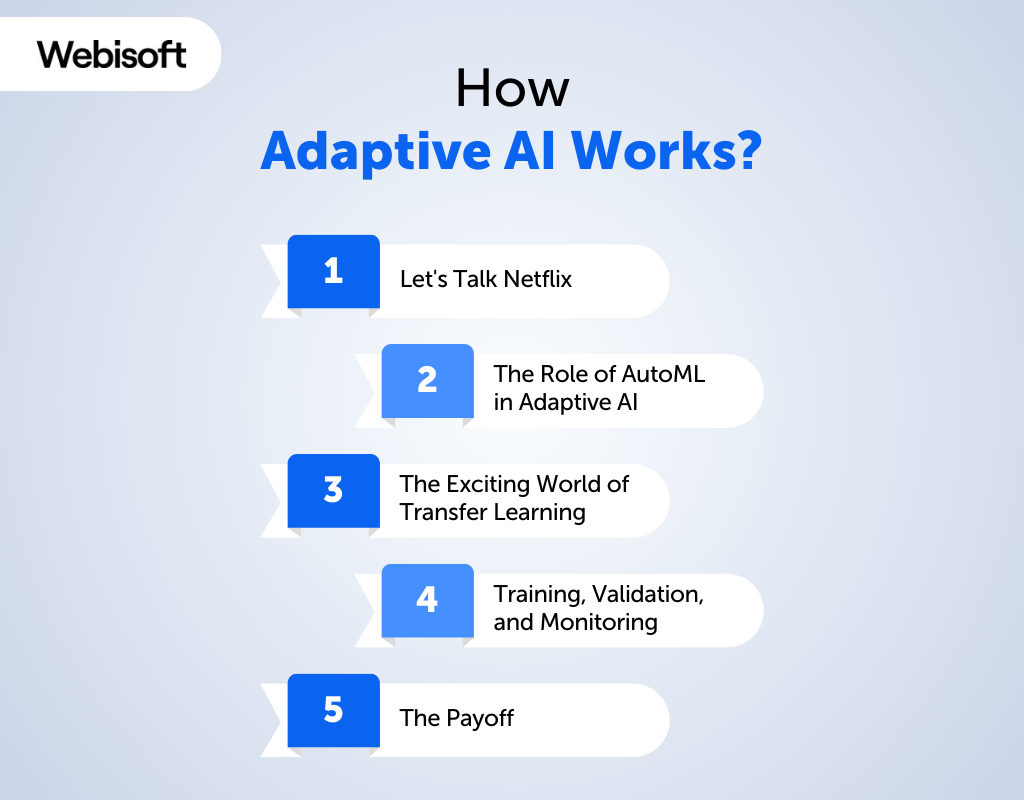
Adaptive AI functions based on a critical component called Continuous Learning (CL). It is a fundamental step in achieving AI.
Continuous Learning (CL) lets an AI model learn and adapt to new data over time. It is similar to how a self-driving car changes its route based on live traffic updates. This process is also known as continuous AutoML or auto-adaptive learning.
CL mirrors the way humans learn and apply knowledge throughout their lives, going beyond the traditional machine learning that works in a fixed setting. With CL, models get updated constantly with new data from the real world.
However, adaptive AI, in general, works in the following ways:
Let’s Talk Netflix
Take Netflix’s recommendation system as one of the most common adaptive AI examples. It continuously updates its suggestions because new shows are always being added, people’s tastes change, and market trends shift.
CL keeps these models accurate and performing well. Data scientists appreciate how CL improves models’ accuracy and efficiency, making them automatically adjust to new data.
The Role of AutoML in Adaptive AI
AutoML plays a crucial role in CL by automating the entire machine-learning process, from data preparation to model deployment.
Its main aim is to reduce human effort, save time, and improve model accuracy by using easy-to-handle frameworks, optimizing hyperparameters, and employing open-source algorithms.
The Exciting World of Transfer Learning
In tasks like computer vision, transfer learning is beneficial. It allows you to start with pre-trained models, adjust them slightly, and quickly put them to use.
For CL, using established models like VGG, Inception, or ResNet is beneficial. Adjusting these models to your needs is crucial.
Training, Validation, and Monitoring
After training, you must validate your models to ensure they work correctly. Choose the best one for deployment.
While this might resemble the usual machine learning process, continuous learning adds a twist to ongoing monitoring. This ensures the model stays updated with fresh data.
Interestingly, not all functions require manual labeling, especially in forecasting or recommendations. Once data is ready, it goes back for revalidation and training, completing the cycle.
The Payoff
The real beauty of adaptive AI and continuous learning is how models constantly evolve with new data, leading to ever-improving accuracy and application performance. And there you have it, a simple breakdown of how adaptive AI keeps getting smarter.
How to Implement Adaptive AI?
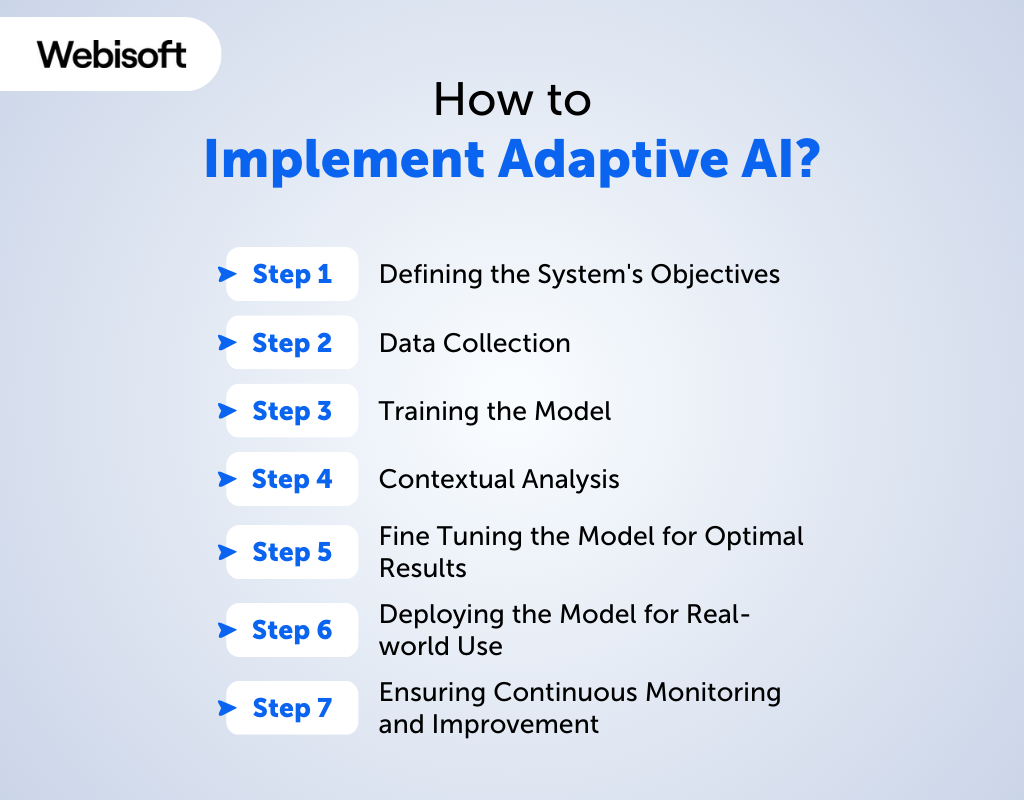
Adaptive AI can change its behavior to fit new situations. If you’re looking to use this technology, here’s how to do it step-by-step.
Step 1: Defining the System’s Objectives
First up, know what you want your AI to do. Your goals could be anything from recognizing images to predicting what users will do next.
It’s also important to figure out how you’ll measure success. Choose metrics that match your goals, like how accurate your AI is. Understand who will use your AI. Different users mean different needs and outcomes.
Step 2: Data Collection
Data is crucial. It teaches AI and helps it make decisions. Make sure your data matches your goals and covers a broad range of scenarios your users might face.
Keep your data up to date to reflect the latest changes. Store your data safely and make sure it’s easy to get to when needed. Protecting user privacy is a must.
Step 3: Training the Model
Now, train your AI with your data. The kind of AI model you choose depends on your specific problem and goals. Clean and organize your data before training. Pick the best settings for your model to work well. Test your model and keep improving it based on the results.
Step 4: Contextual Analysis
Understand the current situation with real-time data. Prepare this data so your AI can use it to make decisions. Keep an eye on how well your AI’s decisions match your goals and adjust as needed.
Step 5: Fine Tuning the Model for Optimal Results
Make small adjustments to get the best performance from your AI. This includes tweaking settings, changing the data your model learns from, and modifying the model itself.
Using several models together can also improve results. Transfer learning can help your AI learn faster from less data.
Step 6: Deploying the Model for Real-world Use
Get your AI ready for real users. Prepare your model, set up the right tech to run it, and then put it into use. Keep your AI running smoothly by regularly checking and updating it. Make sure it works well with other parts of your system.
Step 7: Ensuring Continuous Monitoring and Improvement
Always check how well your AI is doing and look for ways to make it better. Keep feeding it new data, retrain it as needed, and update your system to fix bugs or add new features. Listen to what users say to improve your AI over time.
12 Best Practices for Adaptive AI Implementation
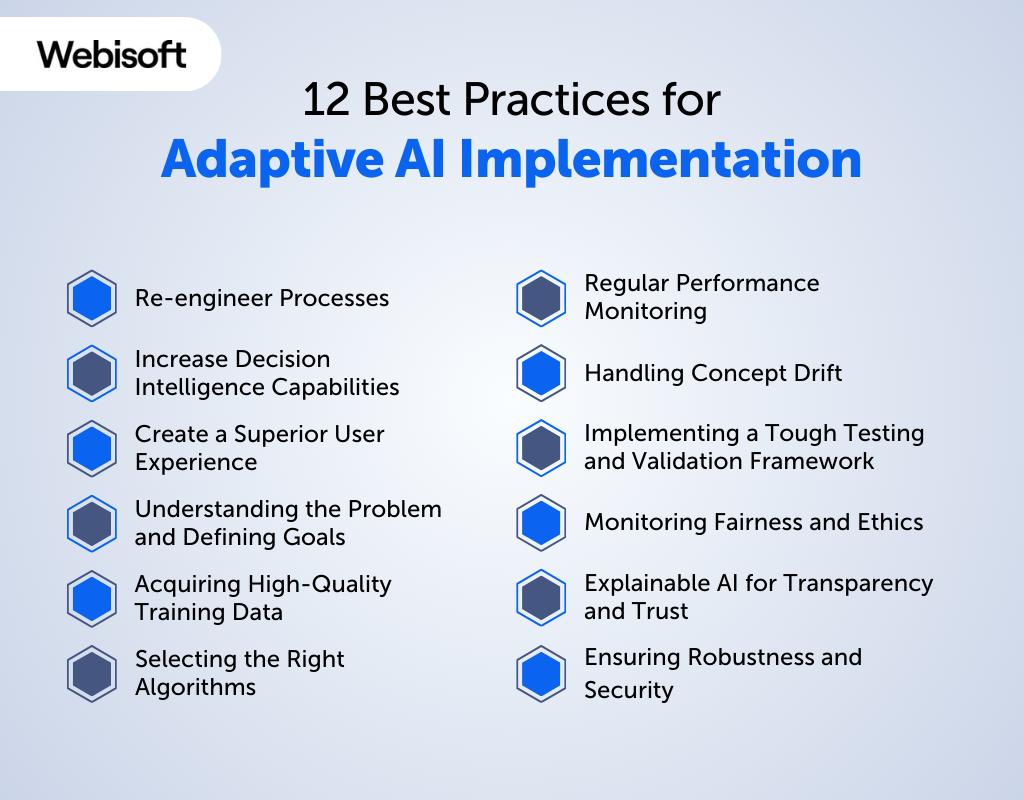
If you’re rolling out adaptive AI, doing it right is crucial. Here’s how you can best practices for adaptive AI implementation:
Re-engineer Processes
First off, IT leaders should revise various processes to fit adaptive AI systems. These systems need to learn and adjust on their own based on different situations.
Increase Decision Intelligence Capabilities
Adding decision intelligence to your setup boosts how flexible and broad your decisions can be. It’s a significant upgrade for any company!
Create a Superior User Experience
Adaptive AI aims to enhance real-world experiences by adjusting to changes as they happen, offering faster and better services to users.
Understanding the Problem and Defining Goals
Knowing the problem you’re tackling is key. It helps in gathering the right data and setting SMART goals. These goals keep your project on track and make it easier to adjust as needed.
Acquiring High-Quality Training Data
The data your AI learns from must be accurate and diverse. Bad data means a poorly performing system. Good, varied data helps the AI handle new challenges.
Selecting the Right Algorithms
The success of adaptive AI also depends on choosing suitable algorithms. Pick those that match your problem and data type, like online learning for real-time data or reinforcement learning for decision-making tasks.
Regular Performance Monitoring
Keep an eye on how your AI is doing. Set clear metrics related to your goals. This way, you can spot and fix problems early.
Handling Concept Drift
When data changes over time, your AI needs to adapt. Use online learning algorithms and keep retraining your system with new data to stay current.
Implementing a Tough Testing and Validation Framework
Testing and validation are non-negotiable. They ensure your AI works well under different scenarios and help pinpoint areas for improvement.
Monitoring Fairness and Ethics
Make sure your AI treats everyone fairly. Check its decisions for bias or discrimination regularly and use bias-reducing algorithms and data.
Explainable AI for Transparency and Trust
Adaptive AI can be complex. Use explainable AI techniques to make its decisions understandable and build trust among users.
Ensuring Robustness and Security
Finally, don’t overlook security. Protect your AI from threats with regular security checks and protect sensitive information.
Exploring the Differences: Traditional AI vs Adaptive AI
To start, let’s check out a comparative analysis of Adaptive AI and Traditional AI:
| Feature | Adaptive AI | Traditional AI |
| Maintenance | Requires continuous monitoring and updates for ongoing learning | Needs minimal maintenance, remains static post-deployment |
| Human Interaction | Necessary | Optional or not needed |
| Learning | Involves continuous learning with real-time updates | Employs batch learning, no post-deployment updates |
| Performance | Enhances over time | Remains constant or declines over time |
| Real-World Application | Ideal for dynamic and evolving environments | Suited for stable and well-defined conditions |
| Adaptability | High, can readily adapt to new information and changing conditions | Low, confined to static training dataset |
| Scalability | High | Low |
| Implementation | Dynamic and flexible | Static and rigid |
Traditional AI has helped organizations speed up their work and become more productive. However, it often falls short in real-world situations because it can’t adapt to new changes on its own.
Adaptive AI, on the other hand, is changing the game. It helps companies be more flexible, strong, and efficient, especially when dealing with complicated business problems.
Adaptive Intelligence vs Artificial Intelligence
Adaptive intelligence allows systems to learn and evolve from new data over time. They adjust their actions based on changes in their environment.
Artificial intelligence, in contrast, operates based on predefined rules and algorithms. It performs different tasks that usually require human intelligence. Both concepts are reshaping how we interact with technology.
However, go through the following table to explore how adaptive intelligence differs from artificial intelligence.
| Feature | Adaptive Intelligence | Artificial Intelligence |
| Learning Ability | Learns and evolves from new data. | Follows predefined rules and algorithms. |
| Flexibility | Adjusts to changes and unforeseen situations. | Operates within a fixed framework. |
| Decision Making | Makes decisions based on continuous learning. | Makes decisions based on static data models. |
| Application Scope | Ideal for environments with constant change. | Best for tasks with predictable patterns. |
| Data Handling | Can process unstructured data in real-time. | Requires well-organized, pre-processed data. |
| User Experience | Offers personalized, context-aware interactions. | Automates tasks without personalization. |
| Innovation Speed | Rapidly integrates new information. | Progresses through developer updates. |
12 Adaptive AI Use Cases
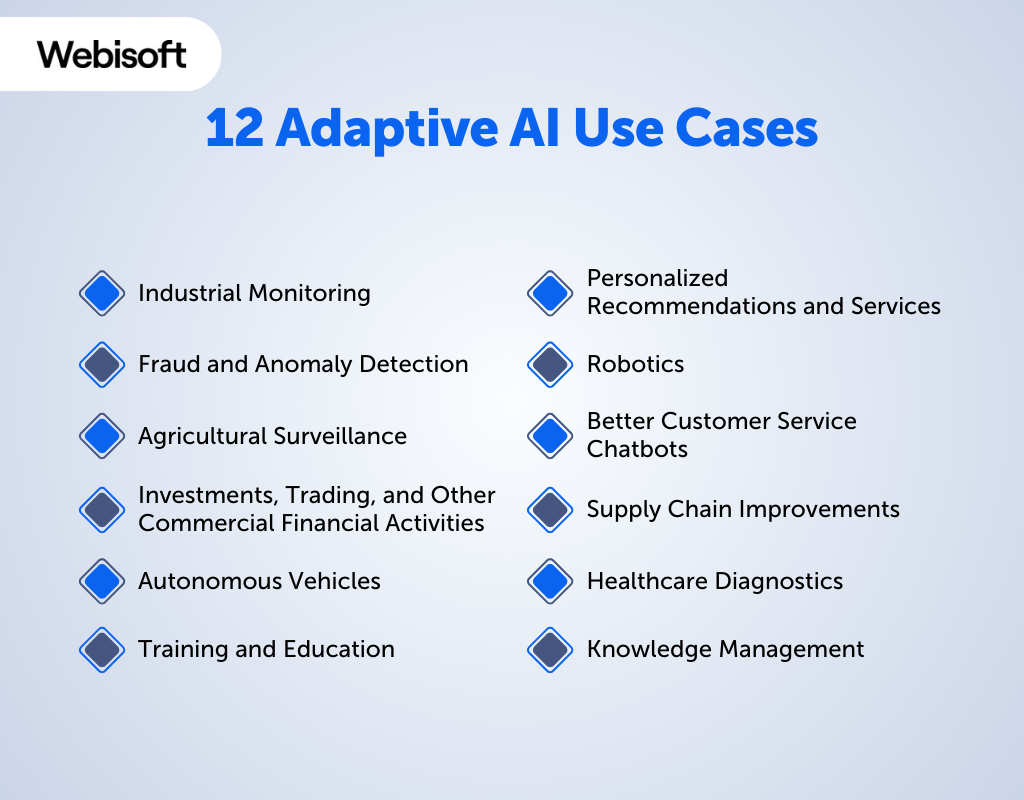
Adaptive AI is changing the game by learning and improving from its surroundings. We’re going to show you 12 ways adaptive AI is making things better across different fields.
Industrial Monitoring
In factories, adaptive AI keeps an eye on machinery, predicting breakdowns before they happen. This smart tech saves companies from unexpected repair costs by getting smarter about spotting issues early.
Fraud and Anomaly Detection
Banks use adaptive AI to catch strange account behavior, helping to stop fraud in its tracks. This AI gets better over time, learning how to spot sneaky tricks more effectively.
Agricultural Surveillance
Farmers turn to adaptive AI for a bird’s-eye view of their fields and animals. It spots problems early, so they can act fast to protect their crops and livestock.
Investments, Trading, and Other Commercial Financial Activities
In the finance world, adaptive AI helps predict where the market is headed, giving investors smart tips. It keeps up with market shifts, offering fresh investment advice.
Autonomous Vehicles
Self-driving cars rely on adaptive AI to make safe choices on the road. They learn from tons of data, constantly improving how they drive.
Training and Education
Adaptive AI personalized learning, making education better for everyone. It figures out what each student needs, offering custom lessons that make learning stick.
Personalized Recommendations and Services
Streaming sites and online stores use adaptive AI to suggest stuff you’ll like. The more you use them, the better their guesses get.
Robotics
Robots with adaptive AI can handle tough tasks and adjust to new challenges. They’re popping up everywhere, from factories to hospitals, making work easier.
Better Customer Service Chatbots
Adaptive AI powers chatbots that help customers any time of day. They learn from each chat, getting better at giving you the answers you need.
Supply Chain Improvements
Adaptive AI makes supply chains run smoother, predicting what will be needed and spotting issues before they cause trouble. This keeps shelves stocked and customers happy.
Healthcare Diagnostics
In healthcare, adaptive AI looks at images and data to catch diseases early. It learns from each diagnosis, getting faster and more accurate.
Knowledge Management
Companies use adaptive AI to sort through tons of information. It helps you find what you need faster, learning from your searches to get better over time.
Ethical Considerations & Challenges: Exploring the Complexities of Adaptive AI
Even though adaptive AI is very promising, it’s crucial to look at the challenges it brings. More data doesn’t always mean better results.
For instance, if adaptive AI gets misleading information or learns incorrect lessons from data, it can lead to bad outcomes for both people and organizations.
Bias is a big issue in adaptive AI. A well-known example is Amazon’s hiring tool, which was biased against women.
It was trained on resumes submitted over the last decade, a time when the tech field was mostly male. This training led the tool to unfairly judge resumes related to women and those from all women’s colleges.
Racial bias is another concern. There have been cases where AI wrongly labeled photos with racist stereotypes or struggled to recognize people of color, mainly because it was trained on data featuring primarily white individuals.
It’s vital to identify and fix these biases to prevent harm and make the most of adaptive AI.
Making sure adaptive AI is ethical, unbiased, and fair is crucial. This way, we can enjoy the advantages of adaptive AI while avoiding its downsides.
The Future of Adaptive AI: What to Expect?
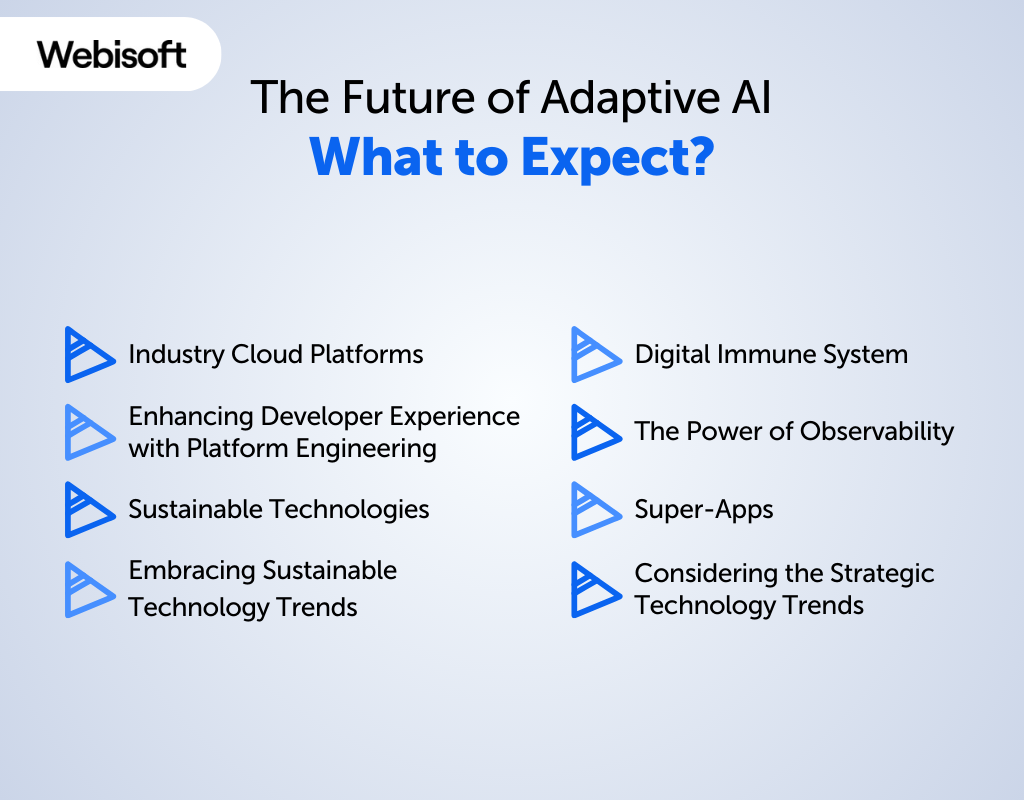
As technology advances, AI is becoming a critical part of business tools. It’s set to transform how we work, making AI essential in the workplace. Now, let’s explore the future of adaptive AI:
Industry Cloud Platforms: Driving Business Growth
Businesses will have to use industry cloud platforms to grow. A survey suggests these platforms will be key to profits by 2024.
By 2027, over half of adaptive AI for business projects will depend on cloud platforms. This change means companies can use cloud benefits like flexibility and scalability.
Enhancing Developer Experience with Platform Engineering
Platform engineering improves how developers work and deliver products. By 2026, 80% of software companies are expected to use internal platforms that help developers. This will make development faster and easier.
Sustainable Technologies
Now, businesses also focus on being sustainable besides making profits. A Gartner survey shows that 63% of leaders are worried about using technology responsibly. AI can help companies be more sustainable.
Embracing Sustainable Technology Trends
Investing in sustainable tech is about looking after the environment and future generations. Tools like emissions management software can save money and support sustainability.
Digital Immune System
Leaders should build a “digital immune system” in 2024. Using AI and data, companies can cut system downtime by up to 80%, improving customer satisfaction and reducing IT risks.
The Power of Observability
Observability helps in making wise decisions with data. Even when data is hard to track, using logs and metrics can offer valuable insights.
Super-Apps
“Super apps” are becoming a big trend. They combine many apps into one, making life easier for users. By 2027, over half the world will use super apps.
Considering the Strategic Technology Trends
Business leaders need to keep an eye on these trends to make the most of adaptive AI. These innovations will shape the future beyond just 2023.
How Webisoft Help to Implement Adaptive AI for Your Business?
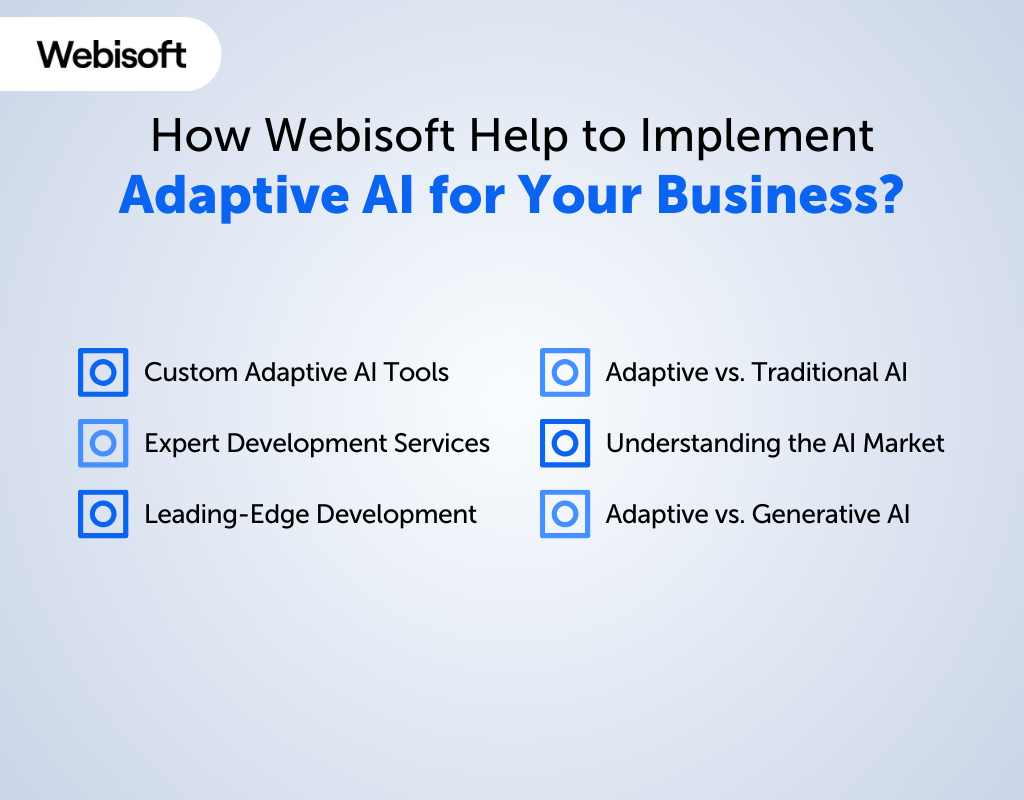
Webisoft gives your business everything it needs to use adaptive AI effectively. Our expertise ensures your AI is state-of-the-art, customized, and continuously improving. Choosing Webisoft means your business can operate more efficiently, connect better with customers, and make smarter decisions.
Let’s explore how Webisoft can help you bring adaptive AI into your business:
Custom Adaptive AI Tools
Webisoft modifies AI tools specifically for your business needs. These tools process lots of data quickly, learning to make your operations more efficient and improving how you serve your customers.
Expert Development Services
Webisoft’s team of experts provides you with adaptive AI development services. They make sure it fits what your business aims to achieve and works well with what you already have. Thus, you get an AI that’s ready to go and easy to use.
Leading-Edge Development
At Webisoft, staying ahead with the latest in AI technology is a priority. They build AI systems that don’t just react to new information but can also predict what might happen next. This helps your business stay agile and ready for anything.
Adaptive vs. Traditional AI
There’s a big difference between adaptive AI and the regular kind. Webisoft focuses on adaptive AI, which learns and changes over time. So, your AI gets better on its own, keeping you competitive without constant manual updates.
Understanding the AI Market
Webisoft helps you figure out how to make the most of the adaptive AI technology. We keep you up to date with the latest trends, ensuring your business doesn’t fall behind.
Adaptive vs. Generative AI
It’s important to know the difference between adaptive AI and generative AI. While generative AI creates new things, adaptive AI improves how it makes decisions based on new information. Webisoft specializes in adaptive AI, focusing on solutions that progress to meet new challenges head-on.
Final Note
Wrapping up, adaptive AI is a big deal for making systems that really “get” how to improve and help us out more over time. It’s not just about the future. But, it’s changing how things work right now, making businesses smarter and more responsive.
If you’re thinking about making your operations smarter and more adaptable, Webisoft is here to help. We’re all about using adaptive AI to take your business to the next level. Reach out to Webisoft today, and let’s make things happen.
Frequently Asked Questions
Why Should Businesses Care About Adaptive AI?
Companies should pay attention to adaptive AI because it can learn from data on its own, adjust to new situations, and make smart choices automatically. It leads to better service for customers, more efficient operations, and staying ahead in a world that’s always changing.
What are the best adaptive AI tools?
Some of the top adaptive AI tools are TensorFlow, IBM Watson, and Google AI Platform. These provide the technology needed for companies to build adaptive AI systems. It gets smarter over time and can handle new challenges as they come up.
How does Adaptive AI ensure ethical and responsible use?
Ethical and responsible use of Adaptive AI involves implementing strong data governance practices. It ensures transparency in AI decision-making processes. Moreover, it incorporates ethical considerations into AI design.
